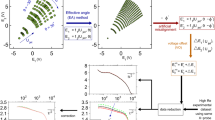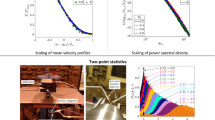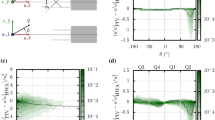Abstract
The use of crossed-wire probes to measure simultaneously the instantaneous stream-wise and normal velocities in supersonic turbulent flows has enabled researchers to investigate the characteristics of organized structures more fully. This paper examines both the practical aspects of using crossed-wire probes in supersonic flow and several methods of converting the resulting signals into useful quantities. Three small perturbation methods are compared in a Mach 2.9 boundary layer, and it is shown that the higher-order terms neglected in the traditional first-order perturbation analysis can alter the instantaneous velocity signals. This is particularly true for regions of intense streamwise mass flux fluctuations. A fourth method, which calculates the instantaneous flow angle directly from the inclined-wire formulation of King's Law, is introduced and discussed. While this method is potentially more accurate than the small perturbation techniques, it is more sensitive to parameter drift during the period between the wire calibration and actual testing.
Similar content being viewed by others
Abbreviations
- A, B, C :
-
sensitivities in the second-order expansion for e′
- D, F E :
-
anemometer voltage
- e′ :
-
anemometer voltage fluctuation
- G :
-
function containing angular dependence of anemometer voltage
- G′, G″ :
-
first and second derivatives of G with respect to φ
- k m :
-
longitudinal mass flux sensitivity
- k mv :
-
transverse mass flux sensitivity
- L :
-
intercept of King's Law
- M :
-
slope of King's Law, Mach number
- n :
-
Ling's Law exponent
- p :
-
pressure
- R Tu :
-
temperature-velocity correlation
- T :
-
temperature
- u, v :
-
instantaneous velocities in the streamwise and transverse directions
- u′, v′ :
-
fluctuating components of u and v
- φ :
-
instantaneous flow angle
- ψ :
-
angle of inclined wire with respect to the probe axis
- ξ :
-
function which relates k m to k mv
- ϱ :
-
density
- (ϱu):
-
instantaneous streamwise mass flux
- (ϱu)′:
-
fluctuating streamwise mass flux
- δ :
-
boundary layer thickness
- γ :
-
= 1.4, ratio of specific heats for air
- τ :
-
Reynolds shear stress, — \( - \bar \rho \overline {u'v'} \)
- x :
-
long-time average of x
- wall:
-
wall value
- 0:
-
tunnel stagnation value
- rms:
-
root-mean-square value
References
Chen, C. P.; Blackwelder, R. F. 1978: Large-scale motion in a turbulent boundary layer: A study using temperature contamination. J. Fluid Mech. 89, 1–31
Clauser, F. H. 1954: Turbulent boundary layers in adverse pressure gradients. Journal of Aeronautical Sciences 21, 91–108
Donovan, J. F. 1989: The structure of supersonic turbulent boundary layers subjected to concave surface curvature. Ph.D. Thesis, Princeton University, Princeton, NJ
Donovan, J. F.; Spina, E. F; Smits, A. J. 1992: The structure of supersonic turbulent boundary layers subjected to concave surface curvature. Submitted to J. Fluid Mech.
Dussauge, J.-P.; Gaviglio, J. 1987: The rapid expansion of a supersonic turbulent flow: Role of bulk dilitation. J. Fluid Mech. 174, 81–112
Fernando, E., M.; Smits, A. J. 1990: A supersonic turbulent boundary layer in an adverse pressure gradient. J. Fluid Mech. 211, 285–307
Fernando, E. M.; Donovan, J. F; Smits, A. J. 1987: The calibration and operation of a constant-temperature crossed-wire probe in supersonic flow. Presented at the Symp. of Thermal Anemometry, Columbus, Ohio
Morkovin, M. V. 1962: Effects of compressibility on turbulent flows. Int. Symposium on the Mechanics of Turbulence, C.N.R.S., Paris, France
Nagib, H. M.; Guezennec, Y. G. 1986: On the structure of turbulent boundary layers. Proc. of the 10th Biannual Symp. of Turbulence, University of Missouri-Rolla
Reshotko, E.; Beckwith, I. E. 1958: Compressible laminar boundary layer over a yawed infinite cylinder with heat transfer and arbitrary Prandtl number. NACA Rep. 1379
Sandborn, V. A. 1974: A review of turbulence measurements in compressible flow. NASA TM X-62 337
Smits, A. J.; Dussauge, J.-P. 1989: Hot-wire anemometry in supersonic flow. AGARDograph No. 315 (Eds. Fernholz, H. H.; Finley, P. J; Dussauge, J.-P.; Smits, A. J.)
Smits, A. I; Muck, K. C. 1984: Constant-temperature hot-wire anemometry practice in supersonic flows, part II: The inclined wire. Experiments in Fluids 2, 33–41
Smits, A. J.; Hayakawa, K.; Muck, K. C. 1983: Constant-temperature hot-wire anemometry practice in supersonic flows, part I: The normal wire. Experiments in Fluids 1, 83–92
Spina, E. F.; Donovan, J. F.; Smits, A. J. 1991: On the structure of High-Reynolds-number supersonic turbulent boundary layers. J. Fluid Mech. 222, 293–327
Willmarth, W. W.; Lu, S. S. 1972: Structure of the Reynolds stress near the wall. J. Fluid Mech. 55, 65–92
Wyngaard, J. C. 1968: Measurements of small-scale turbulence with hot wires. J. Phys. E. Sci. Instr. 1, 1105–1108
Author information
Authors and Affiliations
Rights and permissions
About this article
Cite this article
Donovan, J.F., Spina, E.F. An improved analysis method for cross-wire signals obtained in supersonic flow. Experiments in Fluids 12, 359–368 (1992). https://doi.org/10.1007/BF00193881
Received:
Issue Date:
DOI: https://doi.org/10.1007/BF00193881




